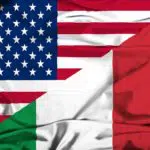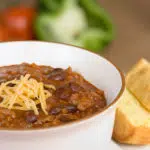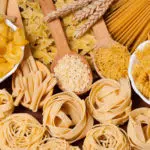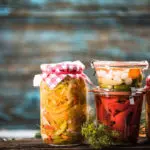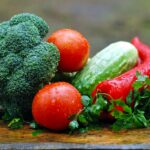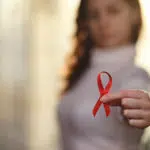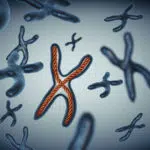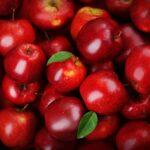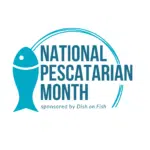October is National Pescatarian Month, an opportunity to learn more about one of the most healthful, fulfilling and tasty lifestyle options available. But first, you may be asking, “What is a pescatarian?” Pescatarians consume seafood combined with a vegetarian diet. It’s a person who eliminates all meat from their diet with the exception of fish (like a vegetarian who still loves sushi or grilled salmon or shrimp!). Making up roughly 5% of the population, pescatarians follow a diet of seafood plus grains, legumes, nuts, seeds, dairy, fruit, veggies and eggs.Experts say “going pescatarian” can augment your intake of vital nutrients (such as omega-3 fatty acids) and lead to numerous health benefits, including improved brain and heart health, protection against diabetes, decreased inflammation, and more. Despite its many benefits only about 5 percent of the population are pescatarians.The National Fisheries Institute (NFI) sponsors National Pescatarian Month as a way to raise awareness about the benefits of a pescatarian diet, spread some fun tips on how to adopt a pescatarian lifestyle (for a few days, weeks, months, or even longer), and highlight all of the amazing ways fish and seafood can be an integral part of any diet or lifestyle. NFI has developed a number of resources for anyone who is pesca-curious including a newly-released e-cookbook, and tons of featured content on their popular Dish on Fish blog.
History of National Pescatarian Month
Before we dig deeper into the pescatarian lifestyle and its benefits, it might be helpful to understand where this practice comes from. The word pescatarian is a neologism combining the Italian word for fish (pesce) with the English word vegetarian. While the term may be a modern invention, the concept of pescatarianism goes back thousands of years. Among the earliest known vegetarians in written history were the Pythagoreans, who took their name from the great Greek philosopher, Pythagoras. They were believed to have subscribed to a meatless diet, but it is strongly suspected that they also ate fish, which would make them some of our first unofficial pescatarians.Throughout the centuries, many other groups adopted a pescatarian-style diet – some by choice, others by necessity. Famously, the Benedictine monks of the Middle Ages abstained from meat but not from fish until at least the 14th century. Other religious orders over time also abstained from meat, qualifying them as pescatarians as well.The modern vegetarian movement in the U.S. has been around since the mid-19th century. It was adopted by certain social and religious organizations and even linked to prominent abolitionists and suffragists. It was not until the early 1990s, however, that the term pescatarian would enter the discussion, coined to describe a vegetarian who also eats fish.The full-fledged pescatarian movement subsequently caught on alongside a noted rise in the popularity of vegetarian and vegan diets. In fact, the pescatarian diet – which features fish as its main source of protein – is sometimes viewed as a plausible transition diet on one’s way to the more-limiting end of the spectrum.Pescatarianism has flourished over the last 25 years and is now a widely accepted dietary practice that’s fed by a profusion of cookbooks, online resources, and endorsements from its followers. Numerous celebrities, including actor David Duchovny, author Margaret Atwood, and musicians Billy Corgan, Amanda Palmer and Henry Rollins, have adopted the diet. So has renowned fitness trainer Jillian Michaels.
National Pescatarian Month timeline
While known for leading a philosophical group of vegetarians, Pythagoras (of theorem fame) also eats fish, making him an early pescatarian.
Saint Benedict, founder and namesake of the Benedictine order of monks, writes a book of rules for his order that includes adherence to a vegetarian lifestyle – and also allows fish.
Though it has been around for literally thousands of years, modern-day pescatarianism finally springs forth from the vegetarian movement. As such, it needs its own name and gets one: a combination of pesca (from pesce, the Italian word for fish) and vegetarian.
The National Fisheries Institute introduces National Pescatarian Month to celebrate the pescatarian diet and help educate the public on the benefits of this lifestyle. In conjunction with National Seafood Month (also in October), the NFI’s efforts for National Pescatarian Month include the release of a pescatarian e-cookbook and the publishing of a great deal of helpful content on its Dish on Fish blog.
National Pescatarian Month FAQs
Is eating pescatarian a healthy way of eating?
Yes it is – and the experts agree! Eating pescatarian provides a multitude of nutrients, with a diet high in Omega 3 Fatty Acids, low in carbs and calories. The U.S Dietary Guidelines for Americans recommend eating seafood at least 2-3 times a week as part of a healthy diet.
What is the best way to cook seafood?
There’s no wrong way to cook seafood! In fact, the variety of species readily available means that there are as many preparation methods as there are types of seafood. Grilled, broiled, sautéed, en papillote, baked, air-fried, cooked in an instant pot, blackened – we could go on! And we’d be remiss if we didn’t point out sushi, raw oysters and clams!
Can I eat seafood if I’m expecting a baby or nursing?
During pregnancy, your nutrient needs increase, especially the need for protein and essential omega-3 fatty acids DHA and EPA. The best premiere food source of DHA and EPA is seafood, which also provides a boatload of protein. From salmon to sardines, critical prenatal nutrients are loaded in our favorite seafood dishes. Following the FDA guidelines (at least 2-3 servings of seafood daily) of the standard American diet, the American Pregnancy Association also advises those in various trimesters of pregnancy to have a seafood-rich diet, as well. While there are many great sources of healthy seafood for prenatal health, it’s best to avoid the following during your pregnancy: Shark; Swordfish; King mackerel; Tilefish; Marlin; Orange roughy; and Bigeye tuna (found in sushi). For more information, check out “The Pregnant Woman’s Guide to Eating Seafood.”
Why should I give the pescatarian diet a try?
Please, let us count the reasons: It’s a healthy diet. It offers many of the benefits of a vegetarian diet, but with seafood as the primary protein component. Seafood is one of the most-sustainable protein sources available. Seafood – whether wild-caught or farmed – has a smaller carbon footprint than other proteins And (drum roll) there are a million delicious ways to prepare fish. Need more evidence? Check out the Dish on Fish blog.
National Pescatarian Month Activities
-
Go Pescatarian
Not to overstate the obvious, but National Pescatarian Month was created to help people take the leap into a pescatarian diet. Try the Pescatarian lifestyle by adding seafood to your meal plan at least 2-3 times a week in addition to veggies. Try it for a week or two, or maybe even the whole month.
-
Become a Pesca-vangelist
Already living that good pescatarian lifestyle? Why not use October as an opportunity to share that joy with the world? Invite your friends to share a seafood meal with you at home or at your favorite seafood eatery. You never know who is on the fence about giving it a try and could use a little knowledge and support (and maybe even a little nudge) to get started.
-
Start with a Plan
As a rule, any lifestyle changes are more successful when you start with a plan! In this case, make it a meal plan. Find some resources for including more fish in your diet like Dish on Fish or any of the other sites linked; that will help you choose seafood as the protein. What’s really cool about seafood is there is so much variety you can change it up all the time. Maybe you already know you love shrimp but haven’t tried salmon as often. Start with what you like and then keep trying new types of seafood flavors and cooking styles you crave. Keep adding seafood to your breakfast, lunch and dinner meal plans until you find a balance that suits you.
Why We Love Seafood
-
It’s a healthy and sustainable protein source.
Whether farm raised or wild caught, seafood is among the healthiest and most sustainable sources of animal protein available. Seafood has a smaller carbon footprint in relation to other protein sources. What is sustainable seafood? Simply put, it is seafood caught or grown in a manner that satisfies the nutritional needs of the current generation without reducing the ability to satisfy the needs of future generations.
-
Every fish has a story.
And we don’t mean the “animated movie” kind of tale. When we say every fish has a story, we mean every type of fish is unique in the way it is raised, caught, prepared and shared. National Pescatarian Month embraces those distinctive qualities.
-
It makes every meal special.
Anytime fish is on the menu is a special time in our book. National Pescatarian Month serves as a reminder that we should be striving to make every meal as healthy and enjoyable as possible. In other words, it tells us to make something more of everyday eating.
National Pescatarian Month dates
| Year | Date | Day |
|---|---|---|
| 2023 | October 1 | Sunday |
| 2024 | October 1 | Tuesday |
| 2025 | October 1 | Wednesday |
| 2026 | October 1 | Thursday |
| 2027 | October 1 | Friday |














































